Chalk Line Reels: How to Choose and Why?
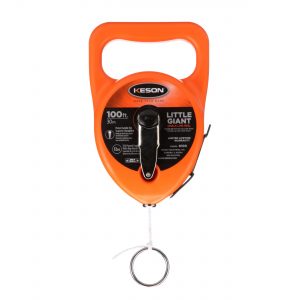
Tools abound on construction sites, but is there anything quite as crucial, yet underappreciated, as a chalk line?
The technology is simple, dating back to ancient Egypt, but is still the standard when it comes to setting a perfectly straight line over feet and yards, leaving a temporary, or even a nearly permanent, mark.
A chalk line reel consists of a few standard components, including:
- Cotton or poly line
- Geared reel
- Plastic casing that houses the line and disperses chalk
Your chalk line casing needs to be refilled periodically to keep your line marking clearly. Depending on your project needs, you can choose from a variety of marking chalks in different colors, visibilities and permanence. All of Keson’s marking chalks are compatible with each of our chalk line reels, but you’ll want to pick the reel that works for your needs.
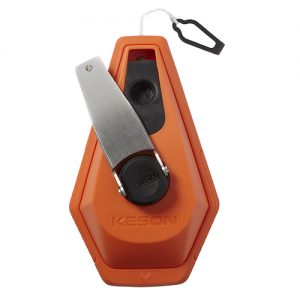
When choosing a chalk line reel, look at the following elements, and consider which combination will best suit your purposes:
- Chalk capacity: Not all models of chalk line reels hold the same amount of marking chalk; the amount can vary from a few ounces to a pound. You’ll want to pick the one that gives you the most number of snaps per refill that isn’t too large to handle so it can be easily carried on the job site.
- Chalk fill closure: Marking chalk is designed to be durable and easily visible. This is a great feature when snapping a line. But it’s not a great feature when it spills on the ground while you try to refill your case, leaving unsightly marks on wood, tile or asphalt. Choose a chalk line reel with a wide opening for a refill, and one that closes securely, to avoid spilling.
- Gear ratio: A chalk line reel’s big selling feature is that you can snap a line hundreds of feet long, but that also means you have to reel in and out hundreds of feet. A reel with the proper gear ratio makes sure all your line comes in contact with the marking chalk—giving you clean snap lines—while also reeling line quickly so you can move on to your next task.
- Line structure: Chalk lines can be braided or twisted. Braided lines use less chalk and put down less chalk with less ghosting. Twisted lines are more durable but also use and put down more chalk, increasing the frequency—and therefore the cost—of refills.
- Line material: Like line structure, line material will impact the clarity of your chalk line. Cotton lines pick up and put down more chalk, which can be helpful if you want a large clearly defined line, but as a natural product, they are more susceptible to moisture damage. Poly lines use and put down less chalk, but are more durable in wet conditions.
So Which One Should You Choose?
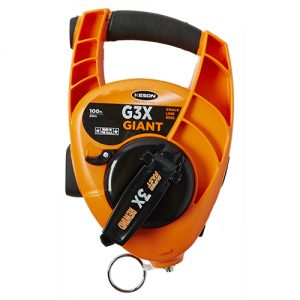
Keson is the only U.S. manufacturer of marking chalk and chalk line reels.
With four product categories of reels and five different types of marking chalk, they work closely with American contractors and builders to develop and improve products that work on local construction sites.
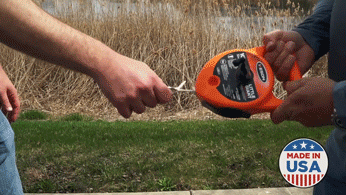
We are in a unique position to interact and respond with the people who build in and build up our communities.
These builders have told us a lot about what’s important in a chalk line reel, and what works and what doesn’t. We continuously add to and improve our chalk and chalk line reels based on the feedback from end-users.
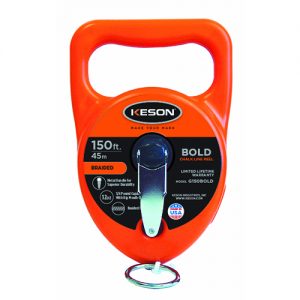
Keson’s four chalk line reels have a number of different features that are designed for different purposes:
- Giant String Chalk Line Reels: These leave thick, bold lines and are ideally suited for parking lots, streets and concrete. The three Giant models hold up to a pound of chalk and 100 to 150 feet of string. Plus, the Giant models come with a BigMouth® chalk port, which is round (just like the openings for chalk bottles) and easy open/easy-and-securely-close system.
- Bold String Chalk Line Reels: These reels leave a slightly thinner line than the Giant reels, somewhere between a felt tip and chisel tip marker. The Bold model is a great solution for outdoor and high traffic areas. The smallest P100 casing holds three ounces of chalk, while the larger G150BOLD and G3X150BOLD hold 12 ounces to a pound.
- Standard String Chalk Line Reels: Keson’s original, and still most popular reel, the poly line puts down more chalk than the Precision models. The K1X and K3X models feature our new Small BigMouth® chalk port for easy filling with Keson marking chalk.
- Precision String Chalk Line Reels: Our finest and most precise reel, the line left by the Precision models is more like a pencil mark. It is ideally suited for indoor work like carpentry, woodworking, tile and mosaic. The K3XPRO model comes with a durable metal casing and Big Mouth chalk port for easy filling.
Like every tool, it’s important to pick the option that works best for your project. A 2.00-millimeter line left with a Giant chalk line and ProChalk Ultimate Dye won’t be the right solution when cutting bathroom tile, just like a Precision chalk line with ProChalk Standard may not give you the definition you need to mark lines in a new parking lot.
To find the right product for you, view Keson’s full line of marking tools or contact us to find a distributor.
